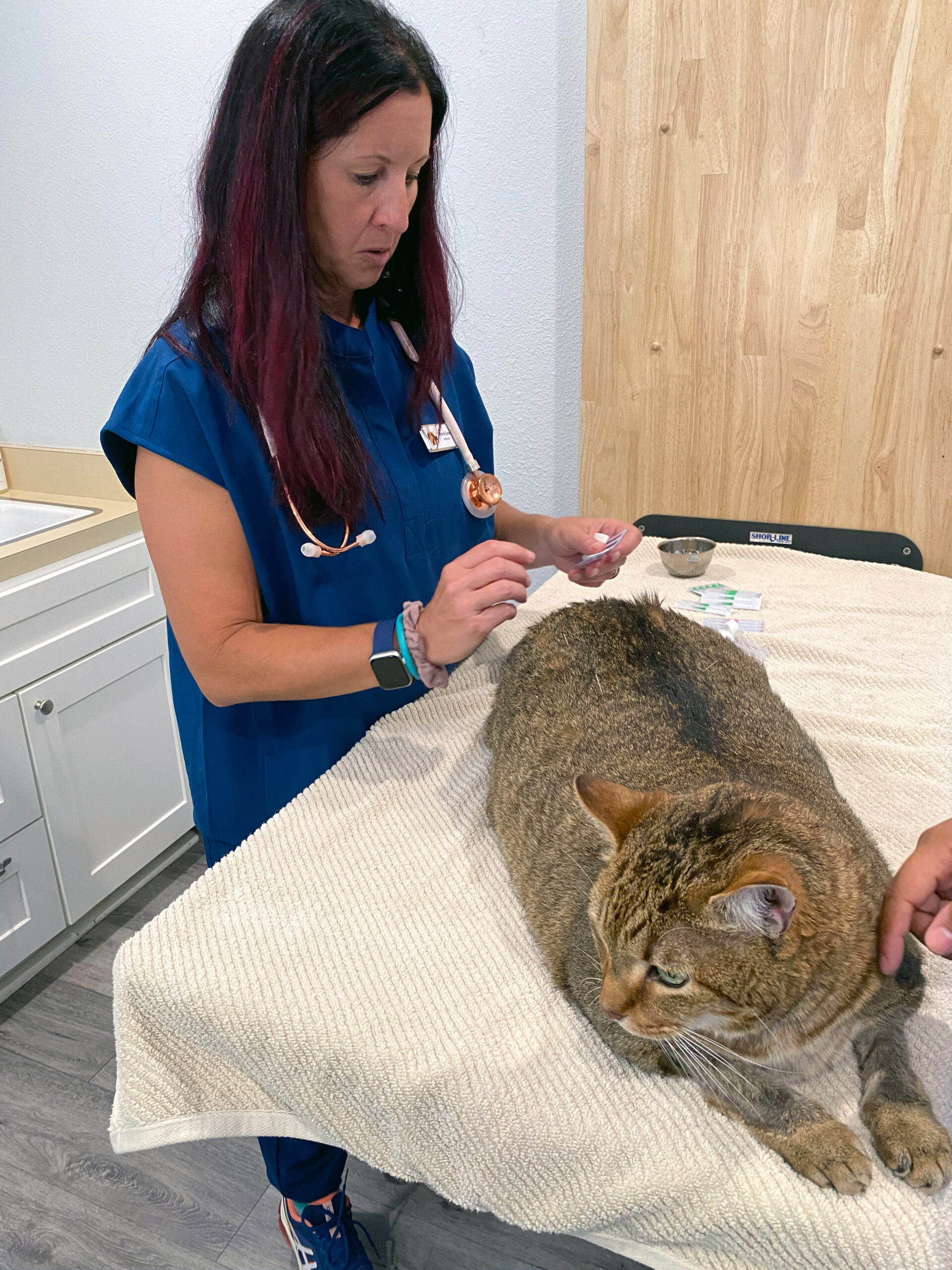Holistic, Eastern and Alternative Medicine
Sometimes, pets need a little something extra to help them with chronic conditions or when conventional services don’t seem to be working.
Our physicians are trained in several alternative medicine practices, to include acupuncture and herbal treatments.
Speak with one of our professionals to see if Eastern medical treatment is right for your pet!

Dr. Love performing acupuncture on a very relaxed and willing participant.

What makes a “healthy” pet?
“Health” can be defined as the balance in an individual’s body as well as the balance between body and mind and between the individual and their environment.
At our practice, we embrace all medical philosophies because not all animals respond to treatment the same. We are certified to perform Eastern medical practices like acupuncture and herbal treatment.
Acupuncture FAQ’s
Traditional Chinese Veterinary Medicine (TCVM) has four main components: acupuncture, herbal medicine, food therapy, and Tui-na (medical manipulation). Acupuncture usually involves the insertion of thin sterile needles into discrete and specific points on the body in order to cause a therapeutic effect, but may include other methods such as electrical stimulation and moxibustion. The point on the body is called “Shu-xue” or acupuncture point (acupoint). The ancient Chinese discovered 361 acupoints in humans and 173 acupoints in animals.
Acupuncture has been practiced in both animals and humans for thousands of years in China. The earliest veterinary acupuncture book, “Bo Le Zhen Jing” (Bole’s Canon of Veterinary Acupuncture), is believed to have been written by Dr. Bo Le in the Qin-mu-gong period (659 B.C.E. to 621 B.C.E.). Veterinary treatment protocols using acupuncture are well-documented in this textbook. Since then, acupuncture has been a part of the mainstream veterinary medical system in China.
Modern research shows that acupoints are located in the areas where there is a high density of free nerve endings, mast cells, small arterioles, and lymphatic vessels. Most acupoints are motor points. A great number of studies indicate that the stimulation of acupoints induces the release of beta-endorphins, serotonin, and other neurotransmitters. The US National Institutes of Health’s National Library of Medicine (www.pubmed.gov) has a total of 34,561 research papers regarding acupuncture and 505 animal specific articles as of February 2021.
Qi (pronounced “chee”) is life force or vital energy. There are two contrasting forms of Qi: Yin and Yang. Yin energy tends to be cool, dark, still, and moving downward, while Yang energy is warm, light, mobile, expanding, and moving upward. Physiologically, Qi flows throughout the body all the time, maintaining a balance of Yin and Yang. When the flow of Qi is interrupted by any pathological factor (such as a viral or bacterial infection), the balance of Yin and Yang will be disrupted and consequently, a disease may occur. Pain is interpreted as the blockage of Qi flow. Acupuncture stimulation resolves this blockage, freeing the flow of Qi and enabling the body to heal itself. Homeostasis is restored when Yin and Yang Qi are in balance.
A Channel or Meridian is where Qi flows inside the body. There are 12 Regular Channels and 8 Extraordinary Channels. The most commonly used acupuncture points are located along these Channels. Each Regular Channel is related to specific paired organs. The network of Channels is called the Jing-Luo system.
Yes! Acupuncture is a very safe medical procedure when administered by a qualified practitioner. Very few negative effects have been found in clinical cases.
Each session may take 20 to 45 minutes; the first session usually takes longer than follow-up appointments.
Some results can be seen immediately but others will require several treatments. Generally a minimum of 3 to 5 treatments 1-2 weeks apart for chronic conditions are needed before one can expect notable improvement.
As in all medicine, this depends on the situation and treatments can be done daily, weekly, monthly, or even further apart depending on the severity and chronicity of the condition.
Rarely! Acupuncture is not painful because acupuncture points are stimulated using very fine needles, almost as thin as a hair. Over 95% of patients are comfortable with acupuncture therapy. Due to the relaxation effect, some animals will fall asleep during acupuncture treatments. In general, sedation is not needed before an acupuncture treatment.
Only licensed veterinarians are qualified to practice veterinary acupuncture in most states in the USA. A veterinarian that is certified in acupuncture is highly recommended.
Studies have shown that acupuncture stimulation induces the following physiological effects:
- Pain relief
- Promotion of tissue healing processes
- Regulation of gastrointestinal motility
- Anti-inflammatory effects
- Immunoregulation
- Hormone and reproductive regulation
- Antifebrile effects
Clinical trials indicate that acupuncture therapy can be effective in the following conditions:
- Musculoskeletal problems: muscle soreness, back pain, osteoarthritis, and degenerative joint disease
- Neurological disorders: seizures, intervertebral disc disease (IVDD), laryngeal hemiplegia, and facial and radial nerve paralysis
- Gastrointestinal disorders: diarrhea, gastric ulcers, colic, vomiting, constipation, and impactions
- Other chronic conditions: skin problems, heaves, asthma, cough, uveitis, renal failure, chronic liver diseases, behavioral problems, infertility, Cushing’s disease, hypothyroidism, hyperthyroidism, geriatric weakness, and anhidrosis.
- Quality of life, cancer, and hospice care
- Performance enhancement and the prevention of disease
Acupuncture should be used with caution in the following conditions:
- fractures
- pregnancy
- open wounds and tumors
Many acupuncturists choose to combine acupuncture with herbal medicine because the use of herbs enhances the effectiveness of acupuncture.
The veterinarian may choose to use Tui-na, a form of Chinese manipulative therapy often used in conjunction with acupuncture and Chinese herbs. From a conventional medicine perspective, Tui-na can be thought of as corresponding to a combination of acupressure, conventional massage, and chiropractic techniques. It can be used to treat both acute and chronic musculoskeletal conditions, as well as many non-musculoskeletal conditions as decided by the attending veterinarian.
Western medicine has relatively recently recognized the positive effect that dietary changes have on many behavior and skin conditions. However, TCVM has long recognized the importance of food therapy in the treatment and prevention of illness. Therefore, TCVM practitioners may recommend the implementation of special food or the elimination of certain food that the animal is currently being fed based on the Traditional Chinese Food Energetics classification and TCVM diagnosis.

